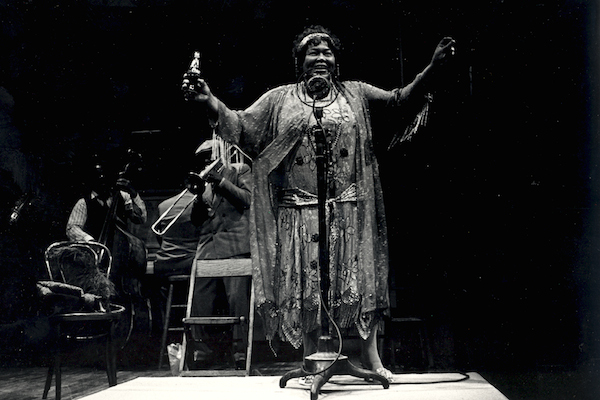Ma Rainey, born Gertrude Pridgett on April 26, 1886, in Columbus, Georgia, is widely regarded as the “Mother of the Blues.” As one of the earliest professional blues singers, she played a pivotal role in shaping the genre and bringing it into the mainstream during the early 20th century. Known for her powerful voice, commanding stage presence, and evocative storytelling, Ma Rainey was a pioneer who laid the groundwork for future generations of blues and jazz musicians.
Overview of Ma Rainey
- Early Life and Career Beginnings: Gertrude Pridgett began performing as a teenager, joining traveling vaudeville and minstrel shows in the South. She adopted the stage name “Ma Rainey” after marrying fellow performer William “Pa” Rainey in 1904. Together, they toured as a duo under the billing “Ma and Pa Rainey.” She became known for her powerful contralto voice and expressive delivery, which captivated audiences and set her apart from other performers of the time.
- Introduction of Blues to Vaudeville: Ma Rainey is credited with bringing the blues to vaudeville and minstrel shows, transforming what was once a rural folk tradition into a commercial urban phenomenon. She began incorporating blues into her performances around 1902, drawing on the music she heard in the southern African American communities where she performed. Her interpretation of the blues blended traditional folk elements with vaudeville flair, making the genre more accessible and appealing to broader audiences.
- Recording Career and “Mother of the Blues”: Ma Rainey’s recording career began in 1923 when she signed with Paramount Records. Over the next five years, she recorded more than 90 songs, including classics like “See See Rider Blues,” “Prove It on Me,” “Bo-Weavil Blues,” “Moonshine Blues,” and “Ma Rainey’s Black Bottom.” Her recordings showcased her distinct, raspy voice and ability to convey deep emotion and storytelling through her music. She sang about love, heartbreak, betrayal, and social issues, giving voice to the African American experience of the time.
- Collaborations and Influence on Jazz: Throughout her career, Rainey collaborated with some of the most talented musicians of the era, including Louis Armstrong, Coleman Hawkins, Fletcher Henderson, and Thomas Dorsey. These collaborations helped bridge the gap between blues and jazz, further solidifying her influence on both genres. Her song “See See Rider Blues,” recorded in 1924 with Armstrong on cornet, became one of the most covered blues songs of all time, influencing countless artists across genres.
- Later Years and Legacy: By the late 1920s, as the recording industry shifted toward more polished and orchestrated blues styles, Rainey’s raw, vaudeville-influenced sound fell out of favor. She retired from recording in 1928 and continued to perform live until 1935. Ma Rainey returned to her hometown of Columbus, Georgia, where she managed two theaters until her death on December 22, 1939. Her influence, however, continued to resonate throughout the blues and jazz worlds and beyond.
Impact on Music and Culture
- Pioneering Female Blues Artist: Ma Rainey is often recognized as one of the first professional female blues singers, paving the way for later artists such as Bessie Smith, Mamie Smith, Billie Holiday, and Etta James. Her success demonstrated that blues music could have a broad appeal and that women could be powerful and successful voices in the genre.
- Authentic Representation of African American Experience: Rainey’s lyrics often touched on themes relevant to the African American experience in the early 20th century, including racism, poverty, love, independence, and resilience. She brought a sense of authenticity to her music, addressing issues that resonated deeply with her audience and providing a voice for marginalized communities.
- Contribution to the Development of the Classic Blues Style: Ma Rainey was instrumental in popularizing the “classic blues” style, characterized by female vocalists accompanied by jazz ensembles. Her work helped to define the genre’s early form and contributed to its evolution, influencing both the lyrical content and musical style of blues and jazz in the decades that followed.
- Empowerment and Gender Expression: Ma Rainey was also known for her bold personality and unapologetic stance on gender and sexuality. Songs like “Prove It on Me Blues” are noted for their subtle references to her own bisexuality and for challenging traditional gender roles. She is considered an early figure of empowerment for women and LGBTQ+ individuals in music.
- Enduring Influence on Blues and Jazz: Ma Rainey’s impact on music is still felt today. Her raw vocal style, emotional depth, and narrative songwriting continue to inspire blues, jazz, and even rock musicians. She was posthumously inducted into the Blues Hall of Fame in 1983 and the Rock and Roll Hall of Fame in 1990, reflecting her lasting importance to the development of American music.
References
- Harrison, Daphne Duval. Black Pearls: Blues Queens of the 1920s. Rutgers University Press, 1988.
- Davis, Angela Y. Blues Legacies and Black Feminism: Gertrude “Ma” Rainey, Bessie Smith, and Billie Holiday. Vintage, 1998.
- Oliver, Paul. Blues Fell This Morning: Meaning in the Blues. Cambridge University Press, 1990.
- Santelli, Robert, ed. The Big Book of Blues: A Biographical Encyclopedia. Penguin Books, 1993.
- Rock and Roll Hall of Fame. “Ma Rainey.” Rock Hall, 1990.


Leave a Reply